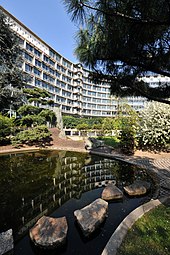Isamu Noguchi | |
|---|---|
 Isamu Noguchi, 1983 | |
| Born | November 17, 1904 Los Angeles, California, US |
| Died | December 30, 1988 (aged 84) New York City, US |
| Education | Columbia University |
| Known for | Sculpture landscape architecture furniture design |
| Notable work | Red Cube (New York City) Black Sun (Seattle) Sky Gate (Honolulu) Akari lanterns Herman Miller lounge table Sapporo Moerenuma Park |
| Movement | Biomorphism |
| Spouse | [1] |
| Awards | Logan Medal of the arts (Art Institute of Chicago)1963; Gold Medal, Architectural League of New York1965; Brandeis Creative Arts Award, 1966; Gold Medal (American Academy of Arts and Letters), 1977; Order of the Sacred Treasure; National Medal of Arts (1987) |

Isamu Noguchi (野口 勇, Noguchi Isamu, English: /nəˈɡuːtʃi/;[2] November 17, 1904 – December 30, 1988) was an American artist, furniture designer and landscape architect whose career spanned six decades from the 1920s.[3] Known for his sculpture and public artworks, Noguchi also designed stage sets for various Martha Graham productions, and several mass-produced lamps and furniture pieces, some of which are still manufactured and sold.
In 1947, Noguchi began a collaboration with the Herman Miller company, when he joined with George Nelson, Paul László and Charles Eames to produce a catalog containing what is often considered to be the most influential body of modern furniture ever produced, including the iconic Noguchi table which remains in production today.[4] His work is displayed at the Isamu Noguchi Foundation and Garden Museum in New York City.
- ^ "Chronology". The Noguchi Museum. Retrieved January 2, 2022.
- ^ "Noguchi". Dictionary.com. Retrieved November 26, 2023.
- ^ Brenson, Michael (December 31, 1988). "Isamu Noguchi, the Sculptor, Dies at 84". The New York Times. Retrieved January 2, 2022.
- ^ Pina, Leslie (1998). Classic Herman Miller. Atglen, Pennsylvania: Schiffer Publishing. ISBN 0-7643-0471-2.